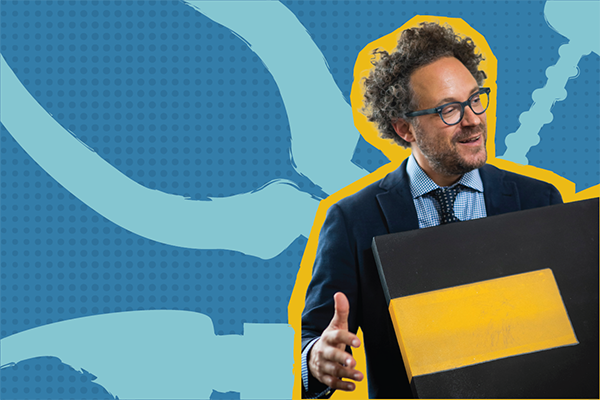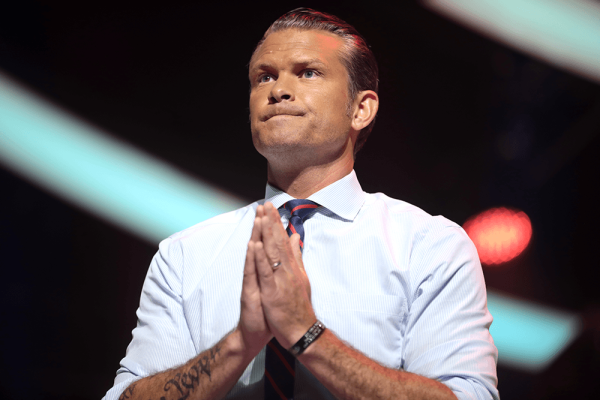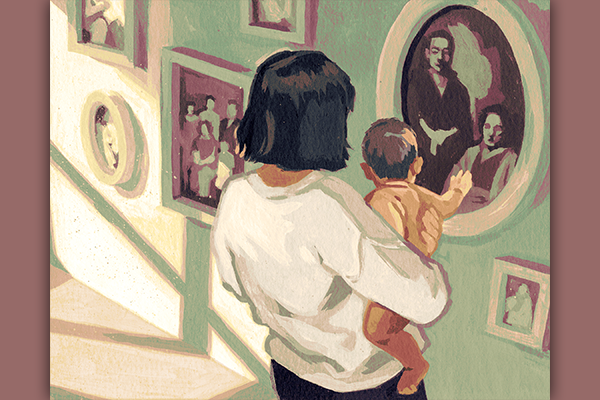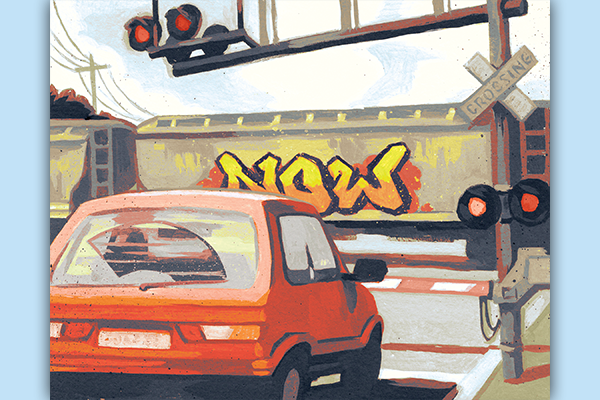This interview is part of The Reconstruct, a new weekly newsletter from Sojourners. In a world where so much needs to change, Mitchell Atencio and Josiah R. Daniels interview people who have faith in a new future and are working toward repair. Subscribe here.
An image that will always cause me to pause is Marc Chagall’s masterpiece, “White Crucifixion.” Chagall was a Belarusian-French artist who lived from 1887 to 1985. Part of the reason his work stirs me is because of its abstract style and religious themes but also because Chagall, who was Jewish, made a point to portray Jesus in his Jewishness.
Growing up as a Christian in the U.S., I was told that Jesus came to die on the cross for our sins and establish the Christian religion. It’s embarrassing to admit, and stands as an example of the way in which casual antisemitism saturates Christianity, but it was not until my college years, after encountering Chagall, that I realized Jesus was distinctly Jewish and that Jews had been offering unique and refreshing ways to see Jesus throughout history.
Writer, art curator, and expert, Aaron Rosen is continuing that tradition, offering new ways to see Jesus from his context as a practicing Jew by inviting people to imagine Jesus as a visual thinker. Aptly titled What Would Jesus See, Rosen’s book encourages people of all backgrounds — Christian, Jewish, or no religion at all — to imagine “how Jesus saw, what he saw, and why this is important today.” The shift from “What would Jesus do?” to “What would Jesus see?” may seem like a way to deemphasize Jesus’ actions. But as Rosen writes: “For Jesus, seeing was doing. At the core of his short ministry was a recurring call to look at the world—and especially its most disadvantaged denizens—with new eyes.”
Rosen also serves as the executive director of The Clemente Course in the Humanities, which provides free, accredited college courses that focus on philosophy, writing, and art to underserved communities. He and his wife, Rev. Carolyn Rosen, co-founded The Parsonage, a nonprofit art gallery in Maine that they run together.
Through his combined knowledge of history, theology, political commentary, and pop-culture references, Rosen makes a compelling case for why investigating what Jesus saw helps us clarify our own moral vision for imagining a future for humanity.
I sat down to speak with Rosen back in September about What Would Jesus See, Judaism and Christianity, and Chagall’s paintings.
This interview has been edited for length and clarity.
Josiah R. Daniels, Sojourners: What inspired you to write What Would Jesus See?
Aaron Rosen: For a long time, I really saw myself as writing to explore my Jewish heritage and identity as a practicing Jew in the context of growing up in a largely non-Jewish area. And then I thought, “Actually, I have this opportunity to talk about my kind of unique vantage point on Christianity, especially being married to an Episcopal priest.”
I live with the Christian liturgy — almost whether I would like it or not — on a weekly basis. I really am always thinking about what my wife is going to preach about on Sunday morning. I always give the example that we snuff out the lights of the candles for Havdalah and then we talk about my wife’s sermon; that’s really close proximity [to Christianity] compared to what most people have for a Jewish life. My wife went with me to synagogue with [our son] last week for Rosh Hashanah. And so we’re very enmeshed in each other’s spiritual lives.
I realized that I had a perspective that might be interesting. I’m certainly hardly the first Jew to write about Jesus; Jews have written obsessively about Jesus from the mid-19th century onwards and created works of art about Jesus. And in fact, my first book Imagining Jewish Art touched a lot on Chagall’s crucifixions.
So I’m certainly not the first, but I do have a somewhat unique perspective on Jesus. I was a little scared because I’m not a New Testament scholar. I really wanted to be clear to people that I have almost no interest in writing about the historical Jesus and I didn’t want to write a straightforward biblical commentary. I wanted to use episodes of scripture as leaping off points to speculate about matters of sight and theological ideas of community and embodiment and other issues.
I grew up Christian and there were two points that were made to us: Jesus came to establish Christianity and die on the cross for our sins. I heard nothing about Jesus being a visual thinker, nothing about connecting Jesus back to Judaism. So why is it important for people to understand that Jesus was a visual thinker and a Jew?
It’s funny, the two points you bring up. I think you could dispute both of them, right? There’s very little evidence in the scripture that Jesus even thought about establishing a church, let alone a new religion. And there’s only a dawning awareness in the later episodes within the gospels that he sees the writing on the wall, as it were, of how things are going to play out for him. And it’s also not clear whether he goes, entirely willingly, toward that end. There’s different shades of how one tells that story.
So I think, one of the reasons to explore Jesus’ Jewishness is, of course, one of the reasons Jews have always been interested: This is an antidote to antisemitism. But I also think it’s a hugely important corrective for the accuracy of Christianity to understand Jesus’ milieu.
And if you believe that Jesus is a savior and everything he said was intrinsically valuable, why would you shut yourself off from understanding the context of what he was actually saying and the kind of language that he would have been familiar with — the passages of the Hebrew Bible that most interested him? So you can only get a deficient understanding of Jesus without understanding his Jewish context.
And also understanding that Jewishness, I think, gives people permission to engage in other forms of interreligious dialogue, and there’s quite a radical humility that happens when Christians say, “Boy, we might have something to learn from Jews,” — not just in an Augustinian sense of Jews as librarians and being better at Hebrew than most Christians — but that they might have a unique understanding of some of the kind of questions that Jesus is wrestling with.
Also, I don’t like to think of anything in terms of purity. So, there’s no sense that Jesus’s significance for Christians is hindered, but only expanded infinitely by recognizing these inter-religious trajectories and understandings.
In terms of why I think of him as a visual thinker, I think that we just get stuck in these ruts theologically and culturally with how we treat Jesus. One of the things that I like about calling him a visual thinker is that I like to think of him not just as transmitting ideas that he’s already precogitated — whether at the beginning of time or whether in his earthly life — but rather that he’s actually figuring things out.
Visual thinking is not just a mode of communication for transmitting an idea, but of discerning it yourself. I really wanted to show those moments when Jesus is thinking through things — where he’s also thinking in collaboration with other people or with his situation. Being aware of the visual dynamics is a way in which he’s constantly adapting and changing the kind of things he’s thinking in those moments.
It offers another way to see what’s very human about him, but also what’s intellectually so rich about his mode of thinking.
In an era of “doomscrolling,” what does it mean to look at the world with care?
That’s one of the areas in which I see Jesus’ attentiveness really coming through at its greatest level; there’s a tenderness in the way he looks at people.
And I think that that tenderness and curiosity is so lost in a lot of the ways we hear Jesus invoked in contemporary political debate — especially from the Right. I think he sees people in their full complexity, so there’s a great irony of people using Jesus to think in a really monolithic way; he’s recognizing people in a way that runs deeper than their own self-recognition, but also allows for room to become ourselves.
I’ve read the gospels many times as a student and episodically as a scholar. But reading them in preparation for this book, it really struck me how much he allows people to become themselves — allows people to recognize this fullness of personhood that’s available to them. The act of being seen is one that catalyzes that development; they might not have even recognized that they had this spiritual potential there until they feel seen.
That certainly comes up in the calling of St. Matthew. I wanted to focus on those moments and flesh those out a little bit: When Jesus is passing by fishermen and says, “Come and follow me,” what does that even look like?
There’s this kind of intrusion into the world in this type of scene. That’s both beyond what we can do as people but also something that we all recognize as wanting to be able to do. We wish that we could look with that kind of sight where we see this ultimate goodness in the destiny of people so much that they want to follow us or join us in some enterprise of good, right?
And, being the kind of Jew I am, I’m not too proud to go looking for that in more unusual places.
What have you found, in your own life, that has helped you be more present?
I don’t think I’m very good at this, actually. Part of writing the book was to talk myself through some of these ideas and ways in which I would like to harness some of this clarity of Jesus’ apocalypticism — to truly see what’s happening at the moment — which is, I think, what he believes in.
In terms of where I’m most present, I think it’s in art museums and the ocean and as a parent. I think I’m more attentive as a parent because there are just so many moments where you think to yourself, “I really don’t want to miss absorbing this.” Kids are so instructive: We teach them to be less spirited but naturally, they’re so joyous and immersed in their life. And it’s amazing.
When my son, who is five, was on the ferry in Seattle, he was like, “Stop everyone! Look, there’s a jellyfish in the ocean,” and he shouted it so loud to everyone who was on the deck of the boat, like, “Look! Stop! What are you doing? Look, there’s a jellyfish. Are you kidding me? You’re not looking at this?” And he does stuff like that all the time. I’m not keen to tamp it down and say, “Oh, you should be quieter,” because it’s just the joyfulness of recognizing something new for the first time.
Marc Chagall is one of my favorite artists, and it was actually his “White Crucifixion” that really forced me, as a Christian, to think about the Jewishness of Jesus and what that might mean for me as a Christian. One of the stories that you tell in the book is about Chagall painting his Exodus piece in a church and how he had apprehensions that Christians might interpret it as promoting a sort of supersessionism. Say more about that.
Chagall really did struggle with that. At the Notre-Dame de Toute Grâce du Plateau d’Assy [where Chagall’s Exodus mural is hung in the baptistry], he wanted to inscribe the phrase “In the name of the liberty of all religions.” He wanted to make sure, especially in a baptistry, [where] the whole idea is that you’re changing over and converting people to be received into Christian community.
He certainly understood that anxiety and was worried about how other Jews would perceive him, but he felt this intensity of this desire of this personal relationship with the image of Jesus.
And one of the things I talked about in my first book is how that’s really a relationship, partly, with a canon. Jesus is a figure that allows him to be in dialogue with Grunewald or Rembrandt and others — to be a great artist is to be a crucifixion painter for him. But it gets converted into this thing where he feels the anguish of Jesus on the cross is a more effective symbol of the suffering of Jews and his own personal suffering in the Second World War than any other image that feels available to him. And I think it’s important for Christian viewers to see in Chagall’s work — especially the “White Crucifixion” — that if they believe strongly in the genius of their own imagery, in their own symbolism as Christians, then you have to also have the humility to say that maybe the symbol is so meaningful that other people can find other things that we don’t see in it.
So I’m really in favor of that kind of radical openness and that kind of hospitality of images. I think — and Rowan Williams talks about this with scripture and in poetry — [that we should] let things mean even more than they seem to mean. That really opens up your capacity to see.
Got something to say about what you're reading? We value your feedback!





